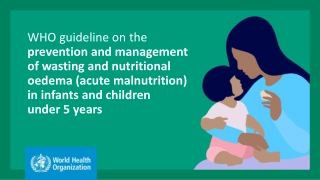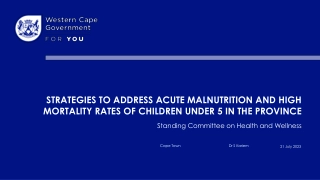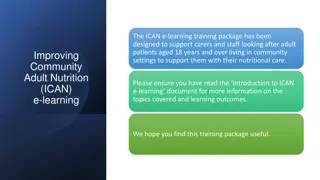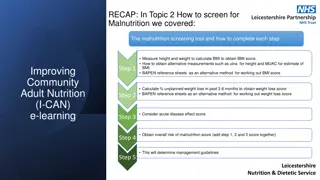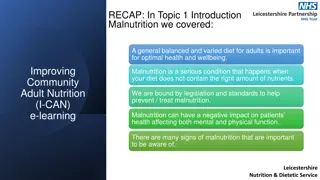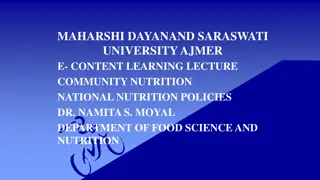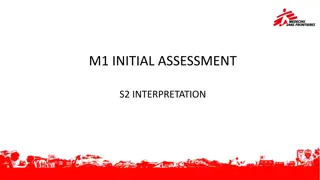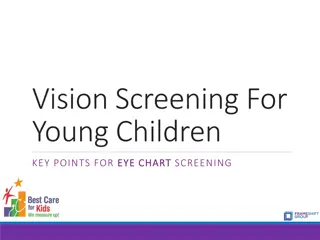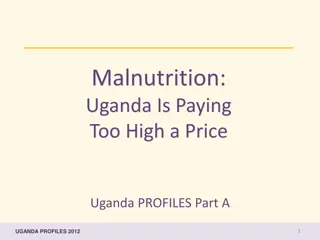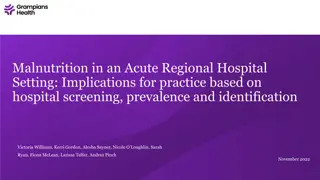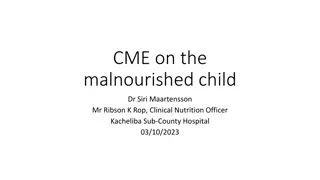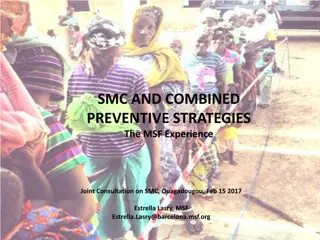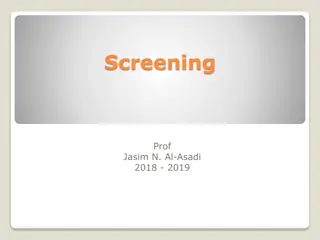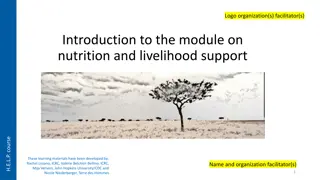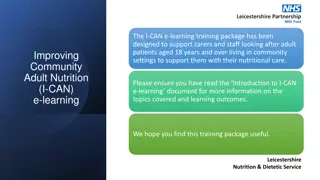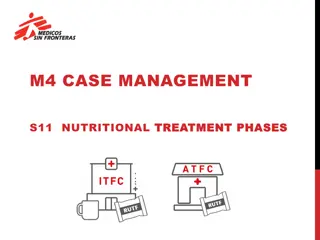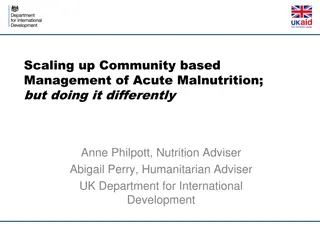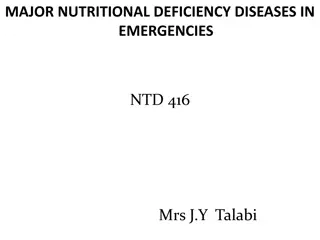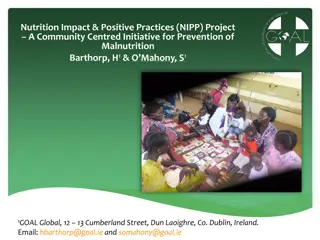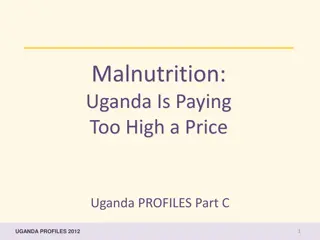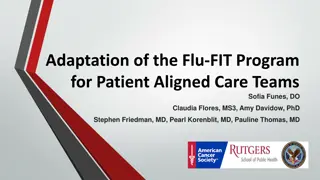WHO Guideline: Prevention & Management of Malnutrition in Infants & Children
Key insights from WHO's guideline on managing wasting and malnutrition in children under 5. Covers assessment, care for infants and mothers, and treatment strategies for different malnutrition levels
3 views • 37 slides
Treatment of Acute malnutrition using Simplified Approaches.
Simplified approaches in the treatment of acute malnutrition involve modifications to existing protocols to optimize effectiveness, quality, and cost-efficiency. These approaches include family MUAC screening, CHW-led treatment, reduced follow-up visits, expanded admission criteria, single treatment
1 views • 15 slides
Nutritional Care Planning for Malnutrition Screening
Learn how to screen for malnutrition using tools like BMI calculation and weight loss assessment. Understand the steps to create a nutritional care plan based on MUST scores, including setting aims, implementing agreed plans, and monitoring progress. Gain insights into managing malnutrition risks an
1 views • 12 slides
Strategies to Address Acute Malnutrition and High Mortality Rates in Children Under 5
Malnutrition in children under 5, specifically acute malnutrition, is a pressing issue in the Western Cape. This presentation outlines the current strategies, multisector engagement, causes, and impacts of acute malnutrition. It delves into the classifications of malnutrition, including severe and m
1 views • 38 slides
Patient Screening and Workflow Process Optimization
The flowcharts and descriptions detail the steps involved in identifying eligible patients for screening, managing patient flow during visits, and tracking screening results. The process includes reviewing patient charts, determining screening eligibility, discussing screening options with patients,
2 views • 5 slides
Understanding Lung Cancer Screening Programs and Criteria
Screening for lung cancer is essential for early detection and intervention. CT scans have shown promise in reducing mortality rates, especially in high-risk populations. While challenges like cost and radiation risk exist, initiatives like the National Lung Screening Trial have demonstrated the eff
4 views • 28 slides
Screening for Malnutrition with MUST Tool
Understanding malnutrition is crucial for maintaining optimal health. Screening with the Malnutrition Universal Screening Tool (MUST) is essential to identify individuals at risk. This tool involves assessing BMI, calculating weight loss scores, and determining overall malnutrition risk. Proper scre
5 views • 25 slides
Supporting Adult Nutrition in Community Settings - ICAN E-Learning Training
The ICAN E-Learning Training Package is designed to assist carers and staff caring for adult patients aged 18 and over in community settings with their nutritional care. The training covers topics such as national standards in nutrition, defining malnutrition, causes and consequences of malnutrition
7 views • 10 slides
Understanding Sanction Regime Framework and Screening Controls
The presented content illustrates the sanction regime framework and screening controls, highlighting the significance of sanctions, who should be screened, and what should be included in the screening process. It covers the scope of sanctions, the importance of sanction screening, tools used for scr
3 views • 42 slides
Global Nutrition Prevalence Rates in Children and Women
This content highlights the prevalence rates of acute malnutrition, severe acute malnutrition (SAM), moderate acute malnutrition (MAM), childhood stunting, acute malnutrition based on MUAC and edema, and acute malnutrition in pregnant and lactating women. The data is based on various criteria such a
9 views • 37 slides
Understanding Malnutrition Screening and Nutritional Care Planning
In this overview, discover the process of screening for malnutrition, including calculating BMI, assessing weight loss, and determining overall malnutrition risk. Explore how to create a nutritional care plan based on the MUST score and set appropriate nutritional aims for patients.
0 views • 12 slides
Understanding Malnutrition Screening with MUST Tool
Delve into the importance of malnutrition screening with the Malnutrition Universal Screening Tool (MUST). Learn how to calculate BMI, assess weight loss, and determine overall malnutrition risk. Discover the key steps involved in using the MUST tool for effective patient care and management.
1 views • 25 slides
Comprehensive Guide to Screening and Prevention in Family Medicine
This comprehensive guide explores the definitions, uses, and levels of screening and prevention in family medicine. It covers the criteria for screening tests, types of screening, examples of targeted populations, and approaches to preventing common problems in primary care. The content discusses th
0 views • 73 slides
Alarming Malnutrition Situation in India: National Nutrition Policy and Strategies
Malnutrition remains a serious issue in India, with high rates of underweight, stunting, and wasting among children. The National Nutrition Policy emphasizes the need for a comprehensive approach to address the complexities of malnutrition. Despite some improvements, malnutrition continues to impact
0 views • 44 slides
Global Nutrition Report 2019: Progress Against Malnutrition Targets
The Global Nutrition Report tracks progress and actions against global nutrition targets, aiming for a world free from malnutrition. Despite efforts, no country is on track to meet targets for adult obesity and anemia in women. The report highlights the coexistence of wasting, stunting, and overweig
0 views • 18 slides
UNICEF Conceptual Framework on the Causes of Malnutrition
The UNICEF conceptual framework on the causes of malnutrition outlines the multidimensional factors contributing to malnutrition, categorized into immediate, underlying, and basic causes. Immediate causes include inadequate dietary intake and diseases, while underlying causes involve issues like ina
2 views • 18 slides
Prostate Cancer Screening Guidelines in Canada: A Snapshot of Strategies
The Canadian Partnership Against Cancer annually collects and summarizes data on national, provincial, and territorial prostate cancer screening guidelines and strategies. Despite the absence of organized screening programs, some provinces have policies in place, with opportunistic screening by prim
0 views • 13 slides
Best Practices for Racial Equity Rapid Response Outreach
This document outlines suggested practices for a racial equity rapid response outreach program, focusing on a workflow for patient outreach, prioritizing patients based on specific criteria, and components of screening including wellness checks and screening for chronic medical conditions. The workf
0 views • 6 slides
Inpatient Management of Severe Acute Malnutrition Training Course 2011
This training course focuses on inpatient management of severe acute malnutrition, teaching procedures outlined in the national Community-Based Management of Severe Acute Malnutrition Guidelines. The training aims to reduce case fatality rates significantly and is designed for physicians, senior nur
0 views • 9 slides
Acute Malnutrition - Fluid Management and Treatment Overview
Acute malnutrition, particularly severe acute malnutrition (SAM), requires careful fluid management and a structured treatment approach involving stabilization, transition, and rehabilitation phases. This condition results from inadequate dietary intake or acute infections, leading to severe wasting
0 views • 23 slides
Understanding Malnutrition Assessment and Classification
Learn how to interpret malnutrition indices, classify types of malnutrition, recognize acute malnutrition, and grade oedema in this informative session. Explore key learning objectives, types of malnutrition, classification of acute malnutrition, and more. Enhance your knowledge to effectively asses
2 views • 10 slides
Importance of Vision Screening for Young Children
Understanding the critical development of vision in young children is crucial, as vision conditions can go undetected but have significant impacts. Early screening helps in identifying refractive errors, amblyopia, and strabismus for successful treatment. Prevalence statistics highlight the importan
0 views • 23 slides
Maternal Nutrition Training: Integrating Assessment, Counselling, and Support
Maternal nutrition training session aims to educate health providers on the importance of maternal nutrition, causes and consequences of malnutrition, and strategies to break the malnutrition cycle. The training covers topics like defining maternal nutrition, understanding its significance throughou
0 views • 11 slides
Implementing Pulse Oximetry Screening for CCHD in Indiana
Indiana implemented pulse oximetry screening for Critical Congenital Heart Disease (CCHD) for all newborns as mandated by state law. The legislation, effective from January 1, 2012, requires every newborn in Indiana to receive CCHD screening, with exceptions only for religious beliefs. The state wor
0 views • 13 slides
Addressing Malnutrition in Uganda: Challenges and Strategies
Malnutrition remains a critical issue in Uganda, with high rates of stunting, underweight, and micronutrient deficiencies among children and women. The National Development Plan aims to reduce poverty and improve health outcomes through strategies like increasing agricultural productivity and enhanc
0 views • 8 slides
Malnutrition in Acute Hospital Setting: Implications for Practice and Identification
A study on malnutrition in an acute regional hospital setting highlighted a prevalence of 40%, with implications such as impaired wound healing and increased length of stay. Screening tools like the Malnutrition Screening Tool (MST) and Subjective Global Assessment (SGA) were used to assess patients
0 views • 12 slides
Understanding and Managing Malnutrition in Children
Learn about malnourishment in children, including common types like Kwashiorkor and Marasmus, as well as the physiologic consequences and clinical assessments related to malnutrition. Discover key indicators such as weight-for-height, MUAC, and edema, along with micronutrient deficiencies and how th
0 views • 21 slides
Enhancing Cervical Cancer Screening through NHS Cytology Programme
The NHS Cytology Screening Programme aims to reduce incidence and mortality from cervical cancer by offering systematic, efficient screening for pre-malignant diseases. With a history dating back to 1988, the programme targets women aged 25-64, emphasizing the importance of visualizing the cervix an
1 views • 38 slides
Screening and Prevention in Family Practice
Definition of screening and prevention in family practice along with the Wilson-Jungner criteria, types of screening tests, and examples like colonoscopy and breast cancer screening. Objectives include understanding screening types and targeted populations, pros and cons of screening, and appropriat
0 views • 33 slides
Combined Preventive Strategies in Public Health Interventions
MSF's experience in implementing combined preventive strategies focusing on SMC, Vaccination, and Nutrition Screening in various countries like Mali, Niger, Chad, and Nigeria. The interventions aim to address malnutrition, improve vaccination coverage, and reinforce EPI programs. Advantages include
0 views • 7 slides
Understanding Disease Screening and Prevention in Medicine
Explore the concepts of disease screening and prevention in preventive medicine. Learn about the importance of recognizing preclinical cases, the iceberg phenomenon of disease, and the role of medical intervention in arresting disease progression. Discover when to apply screening, the types of scree
0 views • 36 slides
Nutrition and Livelihood Support Module: Building Resilience in Crisis Settings
Explore the impact of crises on livelihoods and nutrition, understand malnutrition frameworks, participate in assessments, and identify crisis-appropriate interventions. Delve into basics of nutrition, malnutrition causes, measuring malnutrition, and nutrition programming in crisis contexts. The cou
0 views • 5 slides
Understanding Malnutrition in Adult Patients: I-CAN e-Learning Training Package
The I-CAN e-learning training package is designed to support carers and staff in community settings looking after adult patients aged 18 and over with their nutritional care. It covers topics such as national standards in nutrition, defining a balanced diet, causes and consequences of malnutrition,
0 views • 10 slides
Understanding Nutritional Treatment Phases in Pediatric Malnutrition
This session covers the different phases of nutritional treatment in pediatric malnutrition programs, focusing on objectives, specifics, and criteria for transitioning between phases. An illustrative case of Annika, a 3-year-old in the Transition Phase, is provided for practical application and unde
0 views • 5 slides
Innovative Approaches in Scaling Up Community-Based Management of Acute Malnutrition
Scaling up community-based management of acute malnutrition is vital for reaching vulnerable populations. DFID's efforts in countries like Malawi, India, and Ethiopia showcase unique strategies such as local production of RUTF, piloting CMAM in communities, and integrating CMAM into national nutriti
0 views • 7 slides
Overview of Cervical Cancer Screening Programs in Canada
The Canadian Partnership Against Cancer conducts an annual environmental scan on cervical cancer screening guidelines and strategies across the country. Organized screening programs are available in most provinces, offering services to asymptomatic women at average risk. This scan provides insights
1 views • 46 slides
Understanding Major Nutritional Deficiency Diseases in Emergencies
Access to food and adequate nutrition is crucial during emergencies to prevent malnutrition-related mortality. Malnutrition results from consuming meals lacking essential nutrients, leading to health issues. Malnutrition in emergencies encompasses acute malnutrition, micronutrient deficiencies, and
0 views • 22 slides
Nutrition Impact & Positive Practices (NIPP) Project Overview
The Nutrition Impact & Positive Practices (NIPP) Project is a community-centered initiative aimed at preventing malnutrition, particularly focusing on women, infants, and young children. GOAL Global designed this project to reduce rates of acute and chronic malnutrition through behavior change inter
0 views • 14 slides
Addressing Malnutrition in Uganda: A Call to Action
Uganda is grappling with the high cost of malnutrition, leading to adverse impacts on health, productivity, and economic development. This collection of presentations emphasizes the urgent need for intervention to prevent further suffering and loss of life. The content highlights the benefits of add
0 views • 7 slides
Implementation of Flu-FIT Program for Patient Aligned Care Teams at East Orange VA
This study details the adaptation of the Flu-FIT Program to enhance colorectal cancer screening rates within patient aligned care teams at the Veterans Affairs (VA) Department. By linking influenza immunization with colorectal cancer screening using fecal immunochemical testing, the project aimed to
0 views • 10 slides
